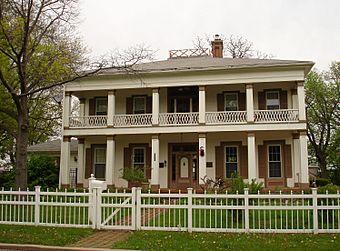John Hossack House facts for kids
Quick facts for kids |
|
|
John Hossack House
|
|
 |
|
| Location | 210 W. Prospect Ave., Ottawa, Illinois |
|---|---|
| Area | 0.6 acres (0.24 ha) |
| Built | 1854–55 |
| Architect | Sylvanus (Sylvannus) Grow |
| Architectural style | Greek Revival |
| NRHP reference No. | 72000462 |
| Added to NRHP | March 16, 1972 |
The John Hossack House is a very old and special house in Ottawa, Illinois, United States. It was built a long time ago, between 1854 and 1855. This house was a secret "station" on the Underground Railroad, a path to freedom for many people. Today, it is recognized as an important historic place.
Contents
The John Hossack House: A Safe Stop
Who Was John Hossack?
The John Hossack House was built by a man named John Hossack. He was born in Scotland and later moved to Ottawa. Before coming to Ottawa, John Hossack worked on the Illinois and Michigan Canal in Chicago.
John Hossack was an abolitionist. This means he strongly believed that slavery was wrong. He worked to end slavery in the United States. He was a brave person who helped many people seeking freedom.
A Secret Stop on the Underground Railroad
John Hossack used his home as a secret stop on the Underground Railroad. This was not a real railroad. It was a network of secret routes and safe houses. These routes helped enslaved people escape to freedom in the North.
John Hossack bravely hid people seeking freedom in his house. He helped as many as 13 people at a time. In 1860, he was part of a famous case. He and other people from Ottawa helped a man named Jim Gray find freedom.
A Special Building Style
The John Hossack House is known as one of Ottawa's most beautiful homes. It sits on the banks of the Illinois River, looking over the city. The house was designed by Sylvanus Grow. Alonzo Edwards helped build it.
The house is a great example of Greek Revival architecture. This style uses ideas from ancient Greek buildings. It has special details and shapes that connect it to classic designs.
Why This House is Important
The John Hossack House is very important for several reasons. It played a big role in the Underground Railroad. It was a safe place for people escaping slavery. The original owner, John Hossack, was also a very important person. He was significant in business and politics in his time.
Because of its history, the John Hossack House was added to the U.S. National Register of Historic Places. This happened on March 16, 1972. This listing helps protect and remember its special past.



